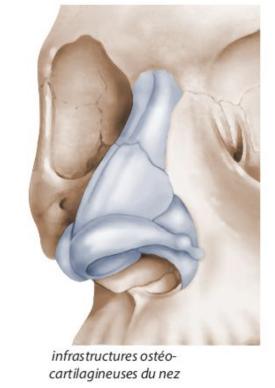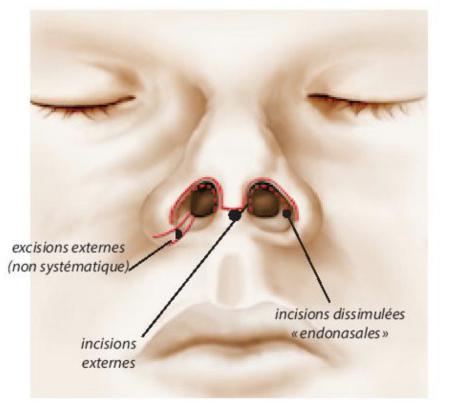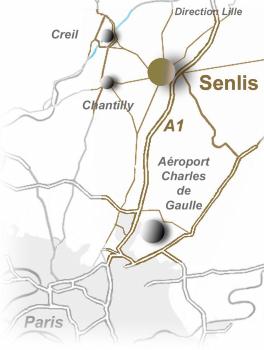AESTHETIC PLASTIC
RECONSTRUCTIVE
SURGERY
SEBASTIEN GARSON M.D
Nose
This fact sheet was developed under the aegis of the French Society of Plastic Reconstructive and Aesthetic Surgery (SOF.CPRE) as an addition to your initial consultation, to try to answer all the questions you can ask yourself if you plan to use surgery baldness. The purpose of this document is to provide you with all the necessary and essential elements of information to help you make your decision with full knowledge of the facts. Also you is it advisable to read with the greatest attention.
• DEFINITION OBJECTIVES AND PRINCIPLES
The term "rhinoplasty" refers to plastic and cosmetic surgery of the nose. The intervention aims to change the morphology of the nasal pyramid (either partially or in whole) and is also sometimes possible to correct nasal breathing problems.
A rhinoplasty can be performed alone or combined, if necessary, other additional procedures in the face, especially genioplasty (chin modification, sometimes carried out in the same operation to improve the overall profile) .
The intervention aims to reshape the nose to embellish it. This is specifically correct the present misfortunes, whether congenital, post-traumatic, or due to the aging process. The goal is to get a natural looking nose, harmonizing in its relations with other facial features, suitable for psychology and personality of the patient, and responding to requests for it. The principle is, from incisions hidden in the nose, reshape the bone and cartilage that make up the solid infrastructure of the nose and give it its peculiar shape. The skin covering the nose should be rehabilitated and redrape thanks to its elasticity this osteochondral structure was changed. This last point highlights the importance of the quality of the skin in obtaining the final result. It is thus understood that rhinoplasty usually leaves no visible scar on the skin.
When nasal obstruction hindering breathing exists, it will be treated in the same operation, whether due to a deviated septum or enlarged turbinates (bony formations present in the nasal cavity).
The operation, performed as well in women as in men, can be performed at the end of growth, that is to say, from about 16 years.
• BEFORE THE OPERATION
Motivations and demands of the patient have been analyzed. A careful study of the nasal pyramid and its relationship with the rest of the face is made, and an endonasal examination. The desired result can be simulated by retouching photographs or computer morphing. The virtual image thus obtained is a project that can help in understanding the desires and expectations of patients. However, we can not in any way commit the result that it is done at any point stackable.
A usual preoperative assessment is conducted in accordance with regulations. The anesthetist will be seen in consultation at least 48 hours before surgery. No medication containing aspirin should be taken within 10 days before surgery. It is essential to continue fasting (nothing to eat or drink) 6 hours before surgery.
• TYPE OF ANESTHESIA AND CONDITIONS OF INTERVENTION
Type of anesthesia: Usually the procedure is done under general anesthesia. However, in some cases, a local anesthetic depth by tranquilizers administered intravenously (anesthesia "vigil") may suffice.
The choice between these techniques is the result of a discussion between you, the surgeon and the anesthetist.
Terms of hospitalization: The intervention can be done in "outpatient", that is to say, day hospitalization with an output on the same day after a few hours of monitoring. However, as appropriate, a shorter hospital stay may be preferable. The input is then carried out in the morning (or sometimes the day before in the afternoon) and the output is allowed the next day or two.
• INTERVENTION
Each surgeon has adopted procedures which are specific to it and it adapts to each case to correct defects in the presence electively and get the best results. It is therefore difficult to systematize the procedure. However, we can retain the common basic principles:
Incisions: Typically, they are hidden, usually inside the nostrils or sometimes under the upper lip, and therefore results in no visible scar on the outside. Sometimes, however, external incisions may be required: either hidden at the base of the nostrils if we should reduce the size of the nostrils or across the columella (pillar separating the two nostrils) to perform a rhinoplasty " open "(to discover nasal infrastructure), sometimes useful when the deformations are large or if it is a surgical recovery.
Dissection: From these incisions, bone and cartilage structure will be isolated by peeling the skin that covers the outside and the mucosa lining the inside.
Corrections:
The osteochondral infrastructure and released can then be reshaped according to the schedule. This basic step can implement an infinite number of processes, the choice will depend to correct anomalies and technical preferences of the surgeon. This will shrink too broad nose, ablate a bump, correct a deviation, a narrow peak shorten a nose too long, recover a partition or reduce annoying horns ... Sometimes cartilage or bone grafts are used to fill a depression, a support portion of the nose or improve the shape of the tip.
Sutures: The incisions are closed with small son, usually absorbable.
Dressings and splints: The nasal cavity can be highlighted heads with different sorbents. A modeling dressing is often made on the surface of the nose using small adhesive strips. Finally, a splint maintenance and protection, plaster or plastic or metal is molded and fixed to the nose, which sometimes go back to the front.
Depending on the surgeon, the extent of the improvements, and the possible need for additional procedures, the procedure can last from 45 minutes to two hours.


AFTER THE INTERVENTION: THE OPERATING SUITES
The suites are rarely painful and it is rather impossible to breathe through the nose (due to the presence of bits) which is the main inconvenience of the first day. We observe, especially the eyelids, the occurrence of edema (swelling) and sometimes bruising (bruises) whose magnitude and duration are highly variable from one individual to another. It is recommended to rest and make no effort day after surgery.
The locks were removed between the 2nd and the 5th postoperative day. The splint is removed between the 5th and 8th day, where it is sometimes replaced by a new smaller splint for a few days. The nose then appear solid enough due to edema and difficulty breathing will still present, due to the swelling of the mucosa and the possible formation of crusts in the nasal cavity. The stigma of the intervention will reduce gradually to return to normal social and professional life after a few days (10 to 20 days depending on the size of the suites). Sports and violent activities are to avoid the first 3 months.
• THE RESULT
Within two to three months is necessary to have a good overview of the results, knowing that the final appearance will be obtained after six months to a year of slow and subtle change. This result is, most often, according to the wishes of the patient and close enough to the project established preoperatively. The intervention provides morphological and aesthetic usually quite significant improvement and a significant psychological benefit. Changes in rhinoplasty are final and only minor and occur late changes associated with the natural aging process (as a non-operated nose).
• FAULTS OF THE RESULT
They may result from a misunderstanding of the goals to be achieved or occur due to scar unusual phenomena or unexpected tissue reactions such as spontaneous rebooting bad skin or retractile fibrosis. These small imperfections, if they are poorly supported, will eventually be corrected by surgical editing, usually much simpler than the initial response, both from a technical point of view that the operating suites. However, such an alteration can not be made for several months to act on tissues stabilized and have reached a good scar maturation.
• POSSIBLE COMPLICATIONS
Rhinoplasty, although carried out mainly for aesthetic reasons, are nevertheless a real surgery, which involves the risks associated with any medical procedure, however small it may be.
We must distinguish the complications of anesthesia and those related to the surgery.
Regarding anesthesia, during the consultation, the anesthetist inform himself the patient anesthetic risks. You should know that anesthesia in the body sometimes unpredictable, and more or less easy to control: the fact of using a fully qualified anesthetist, working in a surgical context, that the risks are now almost statistically insignificant. You should know, indeed, that the techniques, anesthetics and monitoring methods have made tremendous progress over the past twenty years, providing maximum security, especially when the operation is performed outside of the emergency and in a healthy person.
Regarding surgery: choosing a qualified and competent plastic surgeon, trained in this type of surgery, you limit these risks, without removing them completely.
Fortunately, real complications are rare following rhinoplasty performed within the rules. In practice, the vast majority of happens without any problems and patients are fully satisfied with their results.
However, despite their rarity, you should be aware of possible complications:
Bleeding: they are possible the early hours but are usually very moderate. When they are too large, it may justify a new wicking further or a recovery in the operating room.
Bruises: they may require evacuation if they are large or too painful.
Infection: despite the naturally occurring microbes in the nasal cavity, it is very rare. If necessary, it quickly justify appropriate treatment.
Unsightly scars: they can only relate to the external scars (if they exist) and are rarely unsightly enough to require reoperation.
Skin disorders: Although rare, they are always possible, often due to nasal splint. Simple wounds or erosions heal spontaneously without a trace, unlike skin necrosis, fortunately exceptional, which often leave a small scar.
In total there should not overstate the risks, but just be aware that surgery, even seemingly simple, still a small share of hazards. The use of a qualified Plastic Surgeon ensures that it has the training and knowledge required to avoid these complications, or effectively treat if jurisdiction.
These are the pieces of information that we wanted to bring you in addition to the consultation. We recommend that you keep this document, read it again after the consultation and reflect "a clear head." This reflection may raise new questions for which you wait for additional information. We are available to talk during the next consultation, or by phone, or even on the day of surgery when we meet in any way before anesthesia.
CONTACT
Contact Us
Phone : + 33344282959
Address:
7 impasse de la Passerelle 60300 SENLIS
France

Copyright SELARL Dr Garson Pages d'information- Crédits photos : Dr Garson / Libre de droits - Mentions légales
Ce site utilise des cookies à des fins statistiques - Pour en savoir plus, cliquez ICI.
SITE RÉALISÉ AVEC WEBACAPPELLA RESPONSIVE